Introduction
Overlay dentures is a dental prosthesis that covers and is partially supported by natural teeth, natural tooth roots and or dental implants. Overlay denture is designed to alter the shape and height of occlusal surfaces of teeth over which it fits. It may form part of a conventional partial denture or be fitted in a mouth with no teeth missing.[1],[2]
Preventive Prosthodontics empathasizes the importance of any procedure that can deay or eliminate future prosthodontics problems. The overdenture is a logical method for the dentist to use in preventive prosthodontics[3]. Overdenture therapy is essentially a preventive prosthodontic concept since it attempts to conserve the few remaining natural teeth. There are two physiologic tenets related to this therapy:the first concerns the continued preservation of alveolar bone around the retained teeth while the second relates to the continuing presence of periodontal sensory mechanisms that guide and monitor gnathodynamic functions.[4],[5]
Case Report
A 58 year old male patient reported to the department of prosthodontics with the chief complaint of inability to chew food properly.The patient gave a past dental history of an anterior fixed partial denture which got failed due to secondary caries on abutments. On oral examination, all teeth were present except teeth 11,14,15,26,36 and 46 (Fig 1,2). Teeth 12 and 21 were found prepared with questionable biomechanical aspect. The radiographic evaluation was done for 12 and 21 . Root canal treatment was done for both 12 and 21 owing to pulpal involvement .The periodontal findings comprised of gingival recession in mandibular anterior teeth, cervical abrasion cavities in maxillary teeth, increased clinical crown length as an aging process.The mounting of primary casts showed no gross occlusal problems.
A maxillary removable overlay cast partial denture incorporating 12 and 21 prepared teeth with primary copings was planned .
 | Fig 1 : Preoperative View Of Mandibular Arch
 |
 | Fig 2 : Pre Operative View Of Maxillary Arch
 |
Steps in the fabrication of maxillary overlay cast partial denture
1. Surveying of primary cast was performed. (Fig 3).
2. The primary copings were fabricated and the cemented on teeth 12 and 21 with glass ionomer cement. (Fig 4).
3. After cementation of primary copings, an alginate impression of upper arch was made and then poured to make a secondary cast which was therafter surveyed.
4. Cast partial denture framework was designed and so the following mouth preparation was done:
1. Guide planes on distal surface of 13 , 25 and mesial surface of 17 ,27.
2. Occlusal rest seat preparation on distal aspect of 13 , 25 and mesial aspect of 17 ,27.
3. Cingulum rest seat on 13.
 | Fig 3 : Surveying Of Model
 |
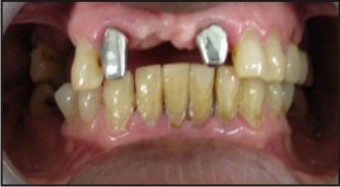 | Fig 4 : Cemented Primary Metal Copings On Teeth 12 And 21
 |
1. A rubber based impression was made for upper arch and was poured in die stone.The cast was then blocked out and duplicated.
2. Wax pattern was adapted on duplicated maxillary cast.(Fig. 5).
3. The casting of wax pattern was done and a metal C.P.D. for upper arch was thus obtained with secondary copings within the metal framework. (Fig 6).
4. Ceramic veneering of facial aspect of 12, 11 and 21 was done. (Fig 7).
5. Try in of metal framework with ceramic veneering on secondary copings. (Fig 8).
6. The overlay C.P.D. was finally inserted in the patient’s mouth. (Fig 9,10,11).
 | Fig 5 : Casting Of Cast Partial Denture
 |
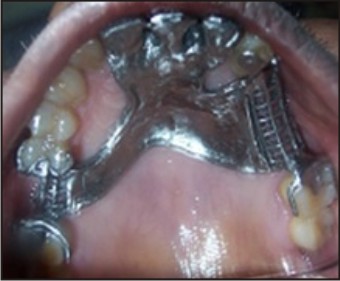 | Fig 6 : Wax Pattern For Cast Partial Denture
 |
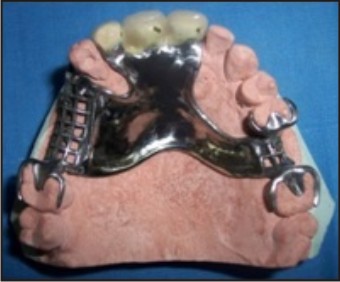 | Fig 7 : Ceramic Veneering
 |
 | Fig 8 : Try – In Of Metal Framework
 |
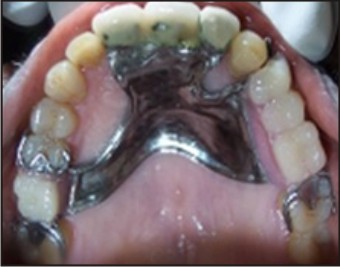 | Fig 9 : Post Operative Occlusal View Of Overlay Cast Partial Denture
 |
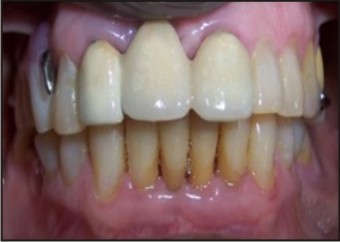 | Fig 10 : Post Operative View Of Overlay Cast Partial Denture In Occlusion
 |
 | Fig 11 : Post Operative View Of Patient While Smling
 |
Discussion
Removable Overlay denture is the prosthesis that covers and is partially supported by natural teeth or tooth roots or dental implant. The long term success of any prosthetic treatment depends on the following [6]:
1. Protection and preservation of the remaining supporting tissues.
2. Optimal distribution of the occlusal forces.
3. Good functional stability, retention, esthetic appearance and oral comfort for many years.
4. Routine oral hygiene should be easy to perform and should not compromise teeth periodontally
This clinical report demonstrated that the use of cast overlay removable partial denture (CORPD) can be a viable, relatively inexpensive, and non invasive choice of treatment for a patient with multiple missing teeth who expresses concerns over treatment longevity, invasiveness, cost and long-term maintenance.
In the presented prosthesis, the following advantages are offered :
1. The secondary copings direct the occlusal forces along the long axis of the teeth and provide good support, guidance and retention.
2. The posterior cast partial design allows cross arch stabilization and multiple abutment splinting.
3. The primary copings are easy to keep clean.
4. The facial veneering of the prosthesis with ceramic provides good esthetics.
5. Co-Cr-Mo metal used which has elastic modulus that equals Type IV gold. It has good rigidity and strength. It is bondable to the ceramic and is highly biocompatible.
6. It is an economically viable option as secondary copings can be modified in case of extraction of any abutments or even teeth supported prosthesis can be converted into tissue borne prosthesis.
7. It requires minimal mouth preparation.
Conclusion
Treatment options vary along with the functional needs, esthetics and economic consideration for each patient. With proper diagnosis and the treatment planning one can try to achieve the better effects from the possible resources.The given cast partial approach addresses to the basic requirements of the treatment by providing good support, retention, stability and esthetics.
References
1. Miller PA .Complete dentures supported by natural teeth.J Prosthet Dent.1959;8:924-928.
2. Academy of Prosthodontics. The glossary of Prosthodontic terms. Mosby Journal Reprint Dept, 2008.
3. John J Sharry. Complete Denture Prosthodontics .Third edition ,New York ,McGraw –Hill Book Co.,1974.
4. Prince IB.Conservation of the supporting mechanism .JPD 1965;15:327.
5. Yalisove IL.Crown and sleeve coping retainers for removable partial prosthesis.JPD 1966;16;1069-85
6. Misch C E , Contemporary implant dentistry 3rd ed .Elsevier, Vol 102;299.
|